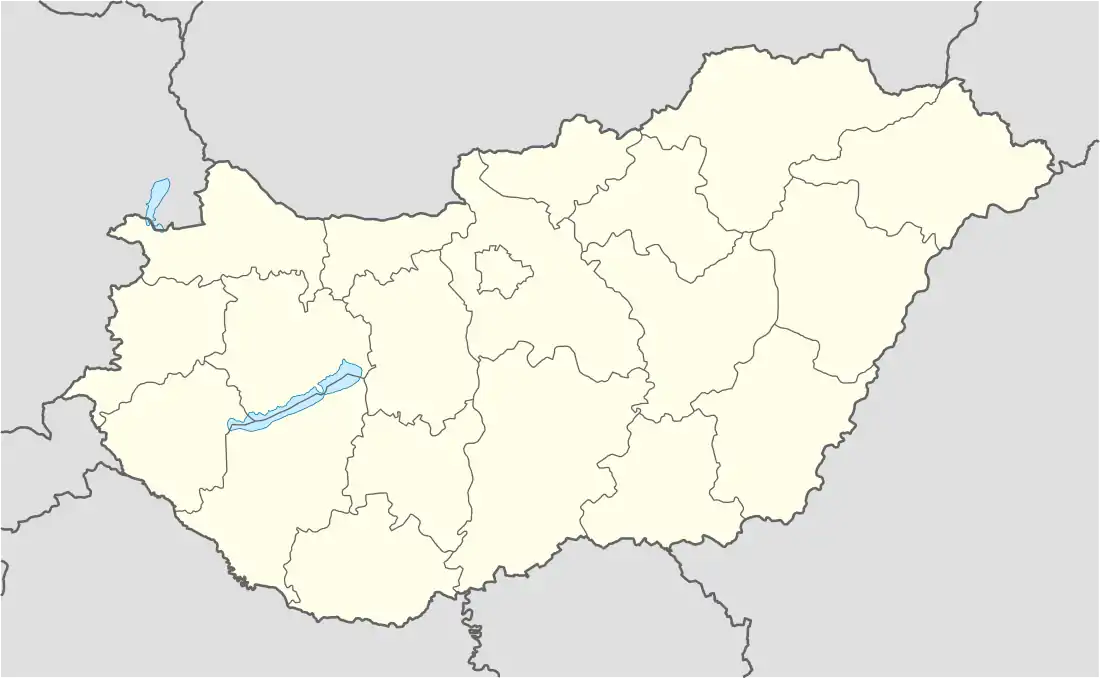Sárospatak
Sárospatak (German: Potok am Bodroch; Slovak: Šarišský Potok, Blatný Potok) (English rough translation: Muddy Stream or Muddy Brook on the Bodrog) is a town in Borsod-Abaúj-Zemplén county, northern Hungary. It lies 70 kilometres (43 miles) northeast from Miskolc, in the Bodrog river valley. The town, often called simply Patak, is an important cultural centre.
Sárospatak
Potamopolis (in Latin) Potok am Bodroch (in German) Šarišský Potok / Blatný Potok (in Slovak) | |
|---|---|
 Sárospatak Castle | |
 Flag  Coat of arms | |
 Sárospatak | |
| Coordinates: 48.31897°N 21.56636°E | |
| Country | |
| County | Borsod-Abaúj-Zemplén |
| District | Sárospatak |
| Area | |
| • Total | 100.5 km2 (38.8 sq mi) |
| Population (2017) | |
| • Total | 11,886[1] |
| Time zone | UTC+1 (CET) |
| • Summer (DST) | UTC+2 (CEST) |
| Postal code | 3950 |
| Area code | (+36) 47 |
| Website | sarospatak |
History

The area has been inhabited since ancient times. Sárospatak was granted town status in 1201 by King Emeric. In the Middle Ages it was an important place due to its proximity to an important trade route leading to Poland.
13th century
Its castle, built by Andrew II, is traditionally identified as the birthplace of his daughter Saint Elizabeth.
15th and 16th centuries
Sárospatak was elevated to the rank of free royal town by King Sigismund. In 1460, during the reign of King Matthias it received the right to hold a market. In the 15th and 16th centuries, it was owned by the Pálóczi (Pálóczy) family, until baron Antal Pálóczi was killed at the first Battle of Mohács in 1526, which precipitated a conflict between the family of his widow, born of the Perényi family, and the Pálóczi-related Dobó family. The Perényi family gained control of the castle, and it was in their possession until 1602, when it passed to the Dobó family.
17th and 18th centuries
Bálint Balassi, the most important Hungarian poet of the century married Krisztina Dobó at the castle; the bride was the daughter of István Dobó, who defended the castle of Eger against the Ottoman Turks. Later the castle was owned by the Rákóczi family. The residents of the town took an active part in the revolution and war of independence against Habsburg rule led by Francis II Rákóczi between 1703 and 1711.
College of Sárospatak
The Reformation began spreading into Hungary from this area. The first Protestant college, one of the most important colleges of Hungary at the time, was founded in Sárospatak in 1531. In 1650 Zsuzsanna Lorántffy, widow of George I Rákóczi prince of Transylvania invited the famous Czech educator Jan Comenius to Sárospatak. Comenius lived there until 1654, as a professor of the college, and he wrote some of his most important works there. The college (since 2000 a faculty of the University of Miskolc) now bears his name.
Hutterite community
In 1631 Hutterites from Alvinc (today Vințu de Jos, Romania) came to Sárospatak to work on constructions.[2] In 1645 George I Rákóczi gave land to Hutterite families in the Héce area of Sárospatak. They came mostly from Csejte (today Čachtice, Slovakia).[3] According to Conrad Jacob Hildebrandt in 1656 there was a significant population of Hutterites numbering 200 people. They were predominantly craftsmen, but some also worked in the agricultural industry. The appearance of the Jesuits in the city in 1663 meant the end of the life of the community. The Jesuit, Johannes Grueber forced them to recatholisation.[4]
Today Sárospatak is a charming historical town and a popular tourist destination.
Climate
| Month | Jan | Feb | Mar | Apr | May | Jun | Jul | Aug | Sep | Oct | Nov | Dec | Year |
|---|---|---|---|---|---|---|---|---|---|---|---|---|---|
| Daily mean °F | 26.1 | 29.8 | 39.7 | 50.4 | 60.4 | 65.3 | 69.6 | 68.0 | 60.6 | 50.4 | 39.0 | 31.1 | 49.3 |
| Daily mean °C | −3.3 | −1.2 | 4.3 | 10.2 | 15.8 | 18.5 | 20.9 | 20.0 | 15.9 | 10.2 | 3.9 | −0.5 | 9.6 |
| Source: [5] | |||||||||||||
Tourist sights

- Castle of Sárospatak (with Renaissance tower)
- Art Gallery of Sárospatak
Notable residents
- Ladislaus IV of Hungary
- John Amos Comenius (From 1650 to 1654, on the invitation of Zsuzsanna Lorántffy)
- Lajos Kossuth
- Elisabeth of Hungary
- Bálint Balassi
- Francis II Rákóczi
- András Fáy
- George II Rákóczi
- Imre Makovecz
- János Erdélyi
- Mihály Tompa
- Miklós Izsó
- Ferenc Berényi
- Johann Grueber
- Ján Chalupka
- Frigyes Ákos Hazslinszky
- Gábor Nagy
- Ilona Zrínyi
- Zsuzsanna Lorántffy
Trivia
- The ceiling of one of the small rooms of the castle is decorated by frescoes of roses. The participants of the Wesselényi conspiracy held their secret meetings in this room. In Latin the term sub rosa means both "under the rose" and "in secret".
- Because of its cultural significance, Sárospatak is sometimes referred as "Athens of the Bodrog".
- One of its secondary schools (Árpád vezér grammar school) was designed by Imre Makovecz.
Twin towns — sister cities
References
- Sárospatak, KSH
- [Vințu de Jos]
- "https://hu.wikipedia.org/wiki/S%C3%A1rospatak". Retrieved September 7, 2020. External link in
|title=(help) - "Testvérvárosok" (in Hungarian). Sárospatak. Retrieved 2019-09-03.
External links
| Wikimedia Commons has media related to Sárospatak. |
| Wikivoyage has a travel guide for Sárospatak. |
- Official website in Hungarian
- Accommodation in Sárospatak

